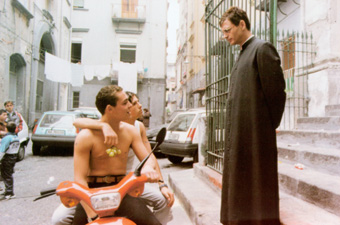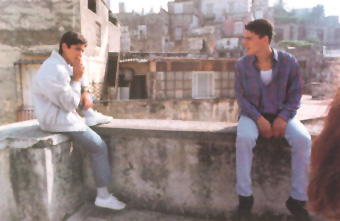 A
hint of the forbidden, the weight of the old apparatus which constantly
threatens to suffocate modern, progressive views – Pianese Nunzio
Fourteen in May is a new contribution to the romanticization of
conflict-stricken life in the church – the most unworthy yet.
A
hint of the forbidden, the weight of the old apparatus which constantly
threatens to suffocate modern, progressive views – Pianese Nunzio
Fourteen in May is a new contribution to the romanticization of
conflict-stricken life in the church – the most unworthy yet.In 1994, first-time British director Antonia Bird spun a tale of a gay priest Greg Pilkington in a paralysed Liverpool church, and his abortive efforts to end the continual sexual abuse of the young girl Lisa by her father. The Priest failed, but was still able to literally lean on the girl for support, as he had become a target because of his homosexuality. A fiasco in the auditorium could be avoided because the abuse of the girl came to light by chance, which earned the director standing ovations she did not really deserve.
Two years later her namesake Antonio Capuano, from Italy, is even more outrageous. This time the abuse vies with the anti-Mafia attitude as the main theme – and the miscreant is the priest himself.
In parts, the film seems to have been made by two different directors, each with their own views on abuse / "paedophilia".
On the one hand, we have a hero in the form of young priest Borrelli, a lone fighter against the Mafia. When boys of Nunzio's age are recruited for organised crime and systematically persecuted and killed by rival bands, and schoolgirls sink to the floor, hit by bullets flying around, the priest refuses to give Holy Communion to his congregation until they wake up from their apathy and come out against the Camorra. The film uses the fact that the priest is gay to generate more sympathy from the audience: the priest has to contend with discrimination, thinks the audience, and in the 90's intellectuals try to outdo each other in terms of their liberal attitudes. When something is done about his going to bed with his pupils, it is to appear malicious, because it is a counter-attack in the fight against the Mafia.
On the other hand the story is told from the boy's point of view. And it is a story of suffering. He consents to the sexual acts, which the priest demands of him, which makes it clear that he is more dependent on him than the other boys. He is tense in school, in his free time more and more at his nerves' ends. Even the slightly older boy Gigi pops up, Nunzio's predecessor in the life of the horny priest. While he is superficially supported by Borrelli, he is made to understand that that is all he can expect. When Gigi complains to Borrelli that he should take more time for him, Borrelli replies that things change. Gigi is now a few years older. Gigi seems to have bad feelings towards the priest not just because of this rebuff, but also precisely because of the old times. Soon the introverted – or disturbed? – 13-year-old becomes a self-assured teenager of "nearly fourteen", who is suddenly able to stand up to the priest verbally.
 These
conflicts of direction confuse the audience: a radical reworking of this
problematic work could actually make it into a stand against sexual abuse.
Someone is aware of the problem of abuse, but the victim is, in the end,
the culprit himself. But if one looks closely, the real message can be
recognised: the boy is meant to be the victim, like all children under
the thumb of the Mafia in one way or another. Evil does not necessarily
come from abuse, as it is here portrayed euphemistically as love for boys
entering puberty – right at the beginning of the film half-naked boys are
to whet the appetite of gay audiences. The damage is caused by the official
reaction to the man's relationship to the boy; teased by other children,
led out of lessons by the police to be questioned and put under pressure.
Probably – according to the film – the boy would have had no problems with
the priest's sexuality, if others left him in peace, rather than putting
things in his head. Depending on your whim, you can claim that the boy
remains silent and protects the priest either because he has "feelings"
for him, or because he is unable to break the dependency he has on his
abuser.
These
conflicts of direction confuse the audience: a radical reworking of this
problematic work could actually make it into a stand against sexual abuse.
Someone is aware of the problem of abuse, but the victim is, in the end,
the culprit himself. But if one looks closely, the real message can be
recognised: the boy is meant to be the victim, like all children under
the thumb of the Mafia in one way or another. Evil does not necessarily
come from abuse, as it is here portrayed euphemistically as love for boys
entering puberty – right at the beginning of the film half-naked boys are
to whet the appetite of gay audiences. The damage is caused by the official
reaction to the man's relationship to the boy; teased by other children,
led out of lessons by the police to be questioned and put under pressure.
Probably – according to the film – the boy would have had no problems with
the priest's sexuality, if others left him in peace, rather than putting
things in his head. Depending on your whim, you can claim that the boy
remains silent and protects the priest either because he has "feelings"
for him, or because he is unable to break the dependency he has on his
abuser.
But with a clear conscience, the priest agrees to be examined, whatever the result of that may be, but not before having heroically led a demonstration against the Camorra, a final act to reflect the essence of the film.
It is, as was its "predecessor" Priest, very well staged. The area of the city, with all its noise, appears authentic, the characters are strong.
Queer View, however, accuses screenplay writer and director Capuano of having pinched wholesale the most disturbing moment from Boaz Yakin's Fresh, although – or perhaps because – this film is unfortunately unknown in non-English speaking Europe. In Yakin's masterpiece of cinematic art a 12-year-old boy campaigns against the various youth gangs who threaten the lives of his family and friends in the "Hood". One of Yakin's effective techniques was, instead of regaling the audience with loads of shoot-outs and action, creating apparently peaceful scenes, in which violence suddenly breaks out, while the camera goes on a journey, at the end of which the full extent of what has just happened is revealed. In this way the new love of the twelve-year-old loses her life when she receives a bullet not meant for her.
Gang warfare in US American cities has been translated to organised
crime in Italian cities. The boy is one year older and also loses his new
love in a key sequence, when she is unintentionally and fatally shot by
rival bands. The diverting and tension-building journey is constructed
among amazingly similar lines. But a copy is just a copy, the quality is
never the same. The scene is not constructed harmlessly and carefully,
but is instead more action-orientated, as a handful of trigger-happy gang
members perform a chase scene over the tracks of a subway station.